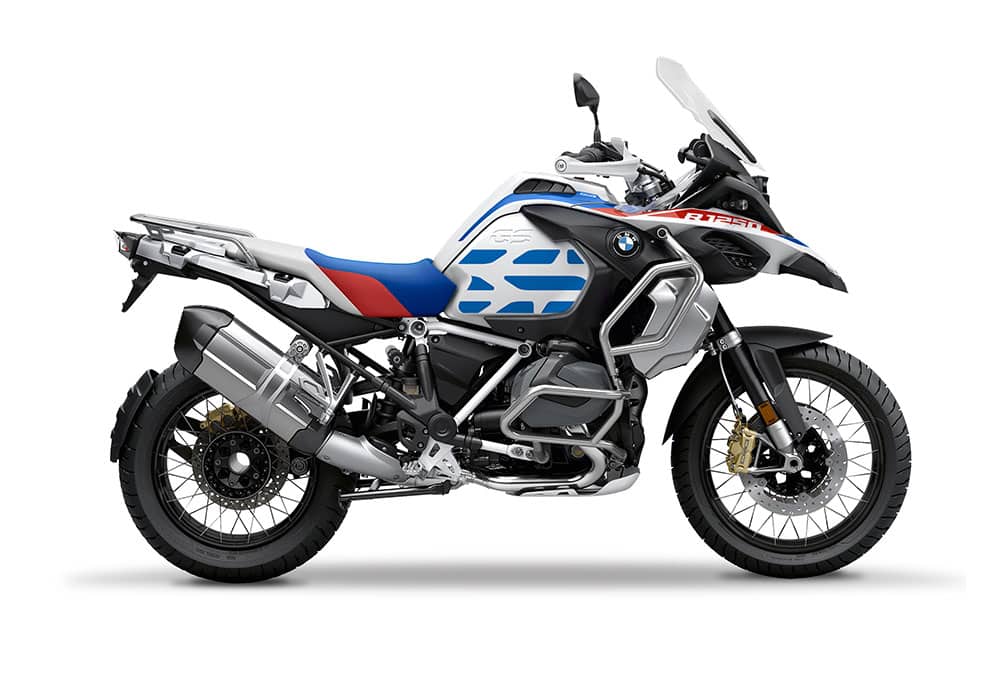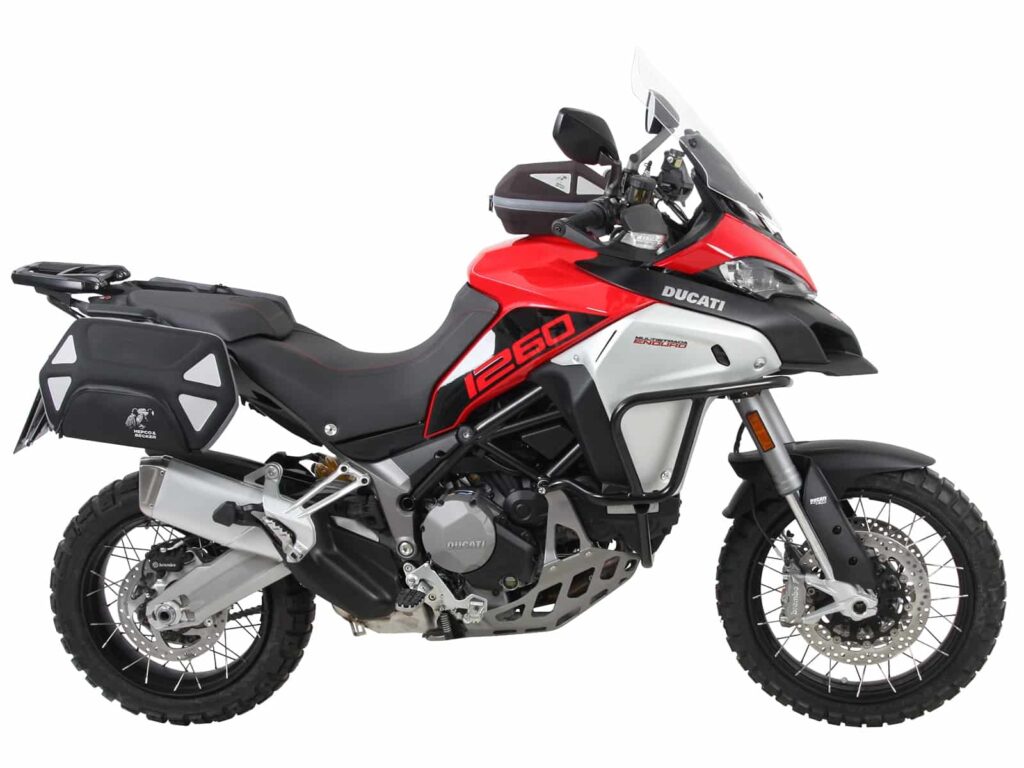If you’ve been riding for numerous years, you will have encountered rain during one of your travels. Whether on a cross-country trek, or just a quick Sunday ride, rain can occur at any time, especially during the winter and spring seasons. Can you ride a motorcycle in the rain? Yes, you certainly can.
Essential Tips for Riding a Motorcycle in the Rain
1. Inspect Your Ride
Before you leave for your ride, there are a few parts to inspect to be prepared for the wet weather.
- Tires: Your tires need to be ready to channel water, meaning they need to have tread. You should inspect your tires for even wear and ensure their pressure is suitable for your motorcycle. An under or over-inflated tire will react differently in water than when it is dry.
- Brakes: Your brake pads should have plenty of brake material to stop as needed during wet weather. If your motorcycle has an ABS unit, make sure that it is checked regularly and in good working order. Check out the video on how to identify wear and tear on your brake pads.
- Oil and Brake Fluid: Check your motorcycle to ensure that there is no leakage, including your oil or brake fluid. An oil leak may not necessarily cause a major safety issue in dry conditions. However, when oil is mixed with water, it becomes a recipe for slippery, unsafe conditions that can end your ride early.
2. Wear the Proper Riding Gear
Before you leave on your ride, protect yourself from the elements with proper riding gear and attire. Note that there are two different types of water prevention clothing, waterproof and water-resistant. Waterproof clothing/gear will not allow water penetration unless under more extreme circumstances, like being submerged in water. Water-resistant gear will shed water from the surface but tend to allow water penetration after a certain period of time when hit with water continuously. When looking for new riding gear for more adverse riding conditions, take note of the type of water prevention the gear is supposed to have.
- Water-resistant/waterproof clothing, including jackets, pants, and one-piece suits, is a must when riding in the rain. For riding gear to have good water protection, the key is overlapping seams that don’t align. Zippers should have a flap (or two) that covers the zipper completely, and the edge of the flap shouldn’t align directly with the zipper. Cuffs on the jacket should be long enough to cover your riding gloves and have a cinching mechanism like a hook-and-loop section that can be tightened around the glove’s cuff. Wet clothes and skin will become cold and will reduce your reaction time to events around you, so it is essential to keep your focus by staying warm and dry. Also, remember that dyed leather gear tends to bleed the color when wet, so you and your gear may end up a lovely shade of blue if not adequately protected from water intrusion.
- Waterproof riding boots and gloves are effective at deterring water penetration. Each needs to fit tight to you to prevent exposed areas for water to find a path through. It’s recommended that they fit tight enough to be tucked into a jacket or rain suit.
- If you have a tank bag fitted to your motorcycle or preferred to ride with a small backpack or saddlebag, consider carrying additional dry clothing.
- For helmets, a full-faced helmet will offer the best protection from water. For those who ride with a ½ or ¾ face helmet pack a set of goggles that can be used in place of normal eye protection. For an added layer of protection on your face, use a balaclava that has a protective outer layer (e.g. Gore-Tex) that will shed water and also block wind from getting to your skin. It should have straps that loop under your arms, keeping the balaclava tucked into your jacket and preventing it from riding up and exposing a potential seam for water to get through.
- Plastic bags are resourceful when you need to keep your valuables dry during a downpour.
3. Prepare Before You Ride
Beyond having the right riding gear for cold or wet weather, there are some other considerations to have in your riding plan.
- Plan Your Route: If the rain turns into a downpour, you should have an alternate path or a rest stop to take shelter in for a brief period or until conditions are safer. Slow rainstorms can turn quickly into gully washers. Mark some favorite restaurants, rest stops, or alternate locations on your GPS or paper map so that you can easily get to if needed.
- Anti-Fogging Treatments: Fogging is also a concern when rain or wet weather conditions are prominent. Fogging occurs when there is humidity and a temperature difference on either side of the object. Therefore, your goggles, helmet visor, and even your windshield can fog up during a rainstorm. Before you depart, wipe the surfaces with an anti-fogging treatment. While wearing your helmet, consider keeping your visor open for ventilation and preventing it from fogging up. If you encounter a situation where fogging is inevitable, pull over until conditions are safer.
4. Beware of Wet Riding Conditions
Wet roads can create dangerous situations for any motorcycle rider. Though it can appear perfectly clean, oftentimes wet roads consist of oils and other slippery residuals on the surface. Be wary and alert of the hazards that heavy rainfall can have on the road in order for you to navigate to your destination safely.
Reduced Traction

Rain unveils oils that create slippery, wet surfaces that reduce the traction on your tires. The first hour of a heavy rainstorm is the most dangerous time to ride, when the oils are raised to the surfaces of the road and have not yet been washed away. If it’s possible to stop for a quick break, now is the time. Wait the storm out or until the rain has thoroughly washed the road surface clean of oils and anything else that has been left behind prior to getting back on your bike. Once the rain has eased up, ride behind the vehicle’s tire tracks, as they have already propelled some of the water away and allow you the gain better traction.
Hydroplaning

A heavy volume of water can also cause you to hydroplane, despite how good or new your tire tread is. Hydroplaning occurs when a layer of water prevents direct contact between the tires and the road. To reduce your chances of hydroplaning, try to avoid riding on painted lines, manhole covers, tar snakes, rainbow-hued puddles, and metal crossings, as they contribute to reduced tire grip.
While riding, slow down as much as possible, squeeze your clutch, and coast through the puddle. At higher speed conditions, try to maintain your speed and avoid abrupt changes as it can reduce the traction of your motorcycle. Also, take into consideration the type of tires you have on your motorcycle. All-weather tires are designed to handle water whereas summer sport tires may not be as resourceful.
Decreased Visibility

The surface presents many challenges, but sometimes what you can’t see in the distance is the biggest obstacle. Visibility of the road and on the road is a big concern. Reflective and/or bright-colored high visibility gear should always be worn while riding in the rain. In dismal conditions, or in the dark, they could be the discerning feature that keeps you visible to other vehicles as their wipers beat across the windshield.
Braking Distance

Braking opportunities will be reduced in wet weather conditions in comparison to dry riding conditions. Braking distance should be increased on the wet road and cornering needs to be slow and steady. It’s best to ride as vertical as possible so your tires have the best contact patch and can whisk away the most water through the treads in your tires. While braking, apply a lighter application to the front brakes. The reduced application of the front brake should be compensated by adding more stopping distance.
Lightning

If there is lightning accompanying the rain, get off the road immediately. Lightning may only seek out tall objects, but that electricity has to go somewhere in the ground. If everything is wet, including yourself, your tires aren’t absolutely going to insulate you from electricity traveling along the ground. Don’t take the chance.

Best Motorcycles for Rain
What parameters did we base ourselves on to make the list of the best motorcycles for rain?
Protection
Without a doubt, one of the most important. Driving a naked is not the same as driving a scooter. In the first one we will have very little protection against the wind and inclement weather, while in the second case, we will be very protected, especially in the part of the legs.
Heating system
Since the arrival of heated grips, any motorcycle that claims to be a good option for winter must have this system mounted. But now, with several models on the market that have heating in the seat, it will be another point to consider.
Lighting
In winter we have fewer daylight hours, with fog, with snow… in short, if we want to be safer and calmer, we must have a state-of-the-art lighting system.
Brakes
It seems obvious, but if we are looking for a motorcycle that will face winter, we must have an adequate braking system, with ABS, that is capable of overcoming possible precipitation or frost.
Technology
Having different driving modes will be of great help when the asphalt is not dry due to that winter morning dew or its temperature is low. Undoubtedly, a “rain” mode will help in both cases since the metered power delivery will give us extra security.
Top 5 Motorcycles for Riding in Rain
Yamaha Niken
The third wheel gives us extra security on wet and even icy surfaces, it is also a motorcycle that has sufficient protection, heated grips, and the latest technology (including different driving modes and ABS braking system) to be within this list.
BMW R1250GS Adventure
Its giant boxer engine covers half the leg, the wide tank the other half, and the screen the body. This, together with its heated grips and seat, the latest technology with different driving modes, and the BMW Integral ABS Pro braking system, make this GS worthy of being on our list of motorcycles for winter.
Peugeot Metropolis 400
A robust and safe motorcycle that will protect you from the cold, will be on your side in terms of stability and safety. Its LED technology lights will light your way on the worst days and all this together with a very comfortable driving position.
Ducati Multistrada 1260 Enduro
It loads a Bosch injection engine, Ride-by-Wire that produces 1,262 cc that produces 158 CV at 9,500 rpm. It has a 6-speed gearbox and Sachs inverted fork suspension with fully electronically adjustable 48mm stanchions. This ensures that this Ducati model has the appropriate technology to be able to circulate on almost any terrain.
Royal Enfield Himalayan
It is a low-power motorcycle that is powered by a single-cylinder engine called the LS 410, with 411 cc and 24.5 hp. Its main virtue is that it has little electronics. The mechanics are basic and in this way, in the event of a mishap in a distant region, it can be repaired in a local workshop instead of going to the official house, a mishap that can ruin the adventure.
Takeaways
When the weather conditions are adverse, safety prevails when making a decision. Knowing the essential tips to ride a motorcycle in the ran, and choosing a premium motorcycle is essential to start an adventure that you will certainly enjoy!














